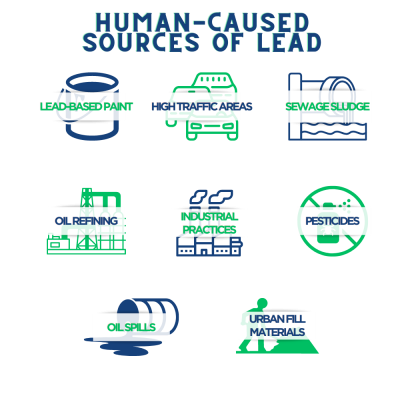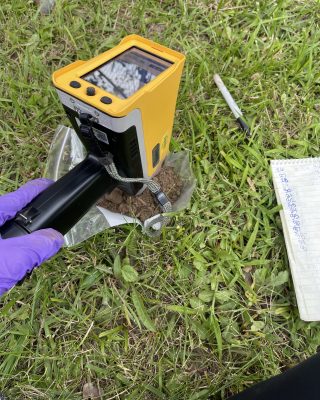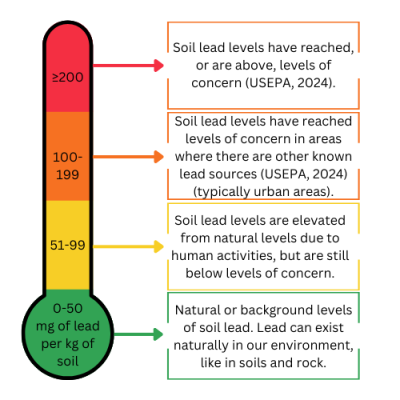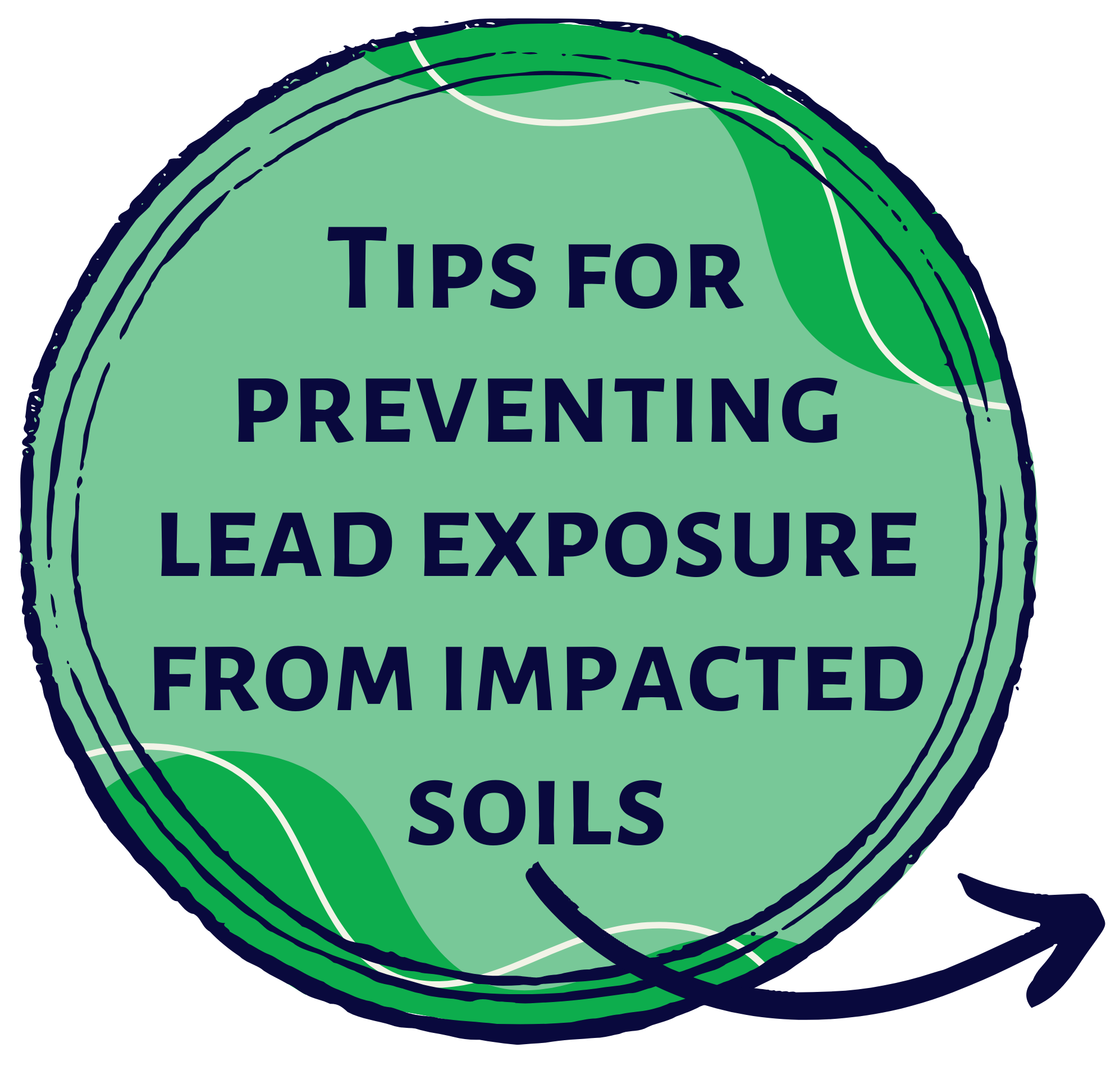
Any questions can be directed to Hayley Clos at hayley.clos@uconn.edu.
WHY ARE WE TESTING THE SOIL FOR LEAD? |

- Lead is naturally present in different parts of our environment, like soils and rock BUT human activities can cause elevated lead levels [1]
- Lead can stay in soil for long periods of time which increases the potential exposure time [2]
- People can be exposed to lead by ingesting unwashed fruits and vegetables, breathing in lead dust, and child hand-to-mouth habits
- Urban areas are particularly susceptible to lead contamination because they typically have many human-caused sources of lead, especially with the use of urban fill material [3,4]
- Understanding soil lead contamination is important prior to gardening, where people can be exposed to lead by interacting with the contaminated soil [5]

Are you interested in soil testing but can't attend one of the workshops listed above? Fill out our short form to request individual testing and we will be in contact with you! [Click Here]
WHO IS AT RISK FROM LEAD EXPOSURE? |

- Lead can be toxic to everyone at high concentrations and long durations of exposure
- Lead is an unessential metal for humans, animals, and plants – meaning no amount of lead in the body is safe
- Examples of essential metals that are important for how human function include sodium, magnesium, calcium, iron, and zinc among others. [6]
- There is also no known safe blood lead level.
- To protect the safety of children, the Center for Disease Control has established a blood lead reference value of 3.5 micrograms per deciliter [7]
- Lead is especially of concern to children under the age of 6
- Lead is a neurotoxin that can lead to stunted development. Children tend to put their hands or other objects in their mouths which may be contaminated with lead (dust, soil particles, etc.)
- Pregnant or breastfeeding people can pass lead to a baby during pregnancy or breastfeeding [7]
- Click HERE for information about blood lead level testing
HOW DO WE TEST THE SOIL? |

 If you want your soil tested, collect samples from your yard - Use our guide to see how to collect your samples
If you want your soil tested, collect samples from your yard - Use our guide to see how to collect your samples- We will be using a Portable X-RAY Fluorescence (pXRF) to test your soils for lead
- pXRF is a tool that can test soils for a variety of metals, especially lead
- This tool is very reliable for detecting lead and can determine low concentrations of lead (as 1 mg per kg soil)
- The pXRF is portable; testing can be done in the field and only take about a minute to get results
| HOW CAN I REDUCE MY RISK OF LEAD EXPOSURE? |

For other gardening tips: https://youtu.be/_3CZJHc_yXM?si=mBYL4LNUEjiHsXI7
|
MORE INFORMATION AND ADDITIONAL RESOURCES |
ENVIRONMENTAL INFORMATION
- CT Department of Energy & Environmental Protection (CT DEEP): www.ct.gov/deep
- U.S. Environmental Protection Agency (USEPA https://www.epa.gov/brownfields/urban-agriculture
- soilShop: https://youtu.be/vl3c706MgOk?si=1joHixR023zuWtZB
HEALTH INFORMATION
- CT Department of Public Health Environmental & Occupational Health Assessment Program: http://www.ct.gov/dph/wastesites
- Agency for Toxic Substances & Disease Registry (ATSDR): www.atsdr.cdc.gov
- Free Health Clinics in Hartford:
- Charter Oak Health Center, (860)-550-7500, 21 Grand Street Hartford, CT 06106
- Charter Oak Health Center – Children’s Services, (860)-545-9300, 282 Washington Street 1G Hartford, CT 06106
- Charter Oak Health Center – Mobile clinic On The Move, (860)-748-9759, 21 Grand Street Hartford, CT 06106
- Community Health Services, (860)-249-9625, 500 Albany Avenue Hartford, CT 06120-2599
GARDENING INFORMATION
- UConn Home & Garden Education Center (HGEC): https://homegarden.cahnr.uconn.edu/
- U.S. Department of Agriculture (USDA): https://www.usda.gov/peoples-garden/gardening-advice

References
[1] USEPA. (2024). USGS background soil-lead survey: State Data. https://www.epa.gov/superfund/usgs-background-soil-lead-survey-state-data
[2] Clark, H. F., Brabander, D. J., & Erdil, R. M. (2006). Sources, Sinks, and Exposure Pathways of Lead in Urban Garden Soil. Journal of Environmental Quality, 35(6), 2066–2074. https://doi.org/10.2134/jeq2005.0464
[3] Abel, S., Nehls, T., Mekiffer, B., & Wessolek, G. (2015). Heavy metals and benzo[a]pyrene in soils from construction and demolition rubble. Journal of Soils and Sediments, 15(8), 1771–1780. https://doi.org/10.1007/s11368-014-0959-4
[4] Swanson, W.R. and Lamie, P. (2010). Urban Fill Characterization And Risk-Based Management Decisions – A Practical Guide. Proceedings of the Annual International Conference on Soils, Sediments, Water and Energy, vol. 12, article 9. Available at: https://scholarworks.umass.edu/soilsproceedings/vol12/iss1/9/
[5] Rosen, C.J. (2002). Lead in the Home Garden and Urban Soil Environment. University of Minnesota Extension Service. The College of Agricultural, Food and Environmental Sciences. https://conservancy.umn.edu/bitstream/handle/11299/93998/2543.pdf?sequence=1&isAllowed=y
[6] Samiullah, M.B. et al. (2023). Essential and non-essential heavy metals sources and impacts on human health and plants. Pure and Applied Biology, 12(2), pp. 835-847. http://dx.doi.org/10.19045/bspab.2023.120083
[7] CDC – National Center for Environmental Health, Division of Environmental Health Science and Practice (2022). Blood Lead Levels in Children. https://www.cdc.gov/nceh/lead/prevention/blood-lead-levels.htm





